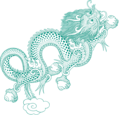The turquoise dragon: symbol of political status?
The Khrims gnyis lta ba’i me long (The mirror of the two laws) is the earliest (known) Tibetan legal treatise. Created in the late fourteenth or early fifteenth centuries, it contains fifteen edicts, the zhal lce bco lnga, which provided inspiration for later legal texts. They are introduced as the g.yu ’brug sgrog pa’i zhal lce so sor bshad pa, ‘an explanation of the edicts, which are (like) the roar of a turquoise dragon’.
What, if anything, was the significance of this image?

The origins, purposes, and date of the treatise are obscure but, as I have suggested, elsewhere, it must post-date the fall of the Yuan empire in 1368, and it seems to have been written by, or for, the Pakmodru (Phag mo gru), as an attempt to consolidate their power in central Tibet.[1] The text expresses traditional ideas about law, emphasizing convergence between religious and royal laws, it includes a short history of law, and it discusses the principles on which mediators should act. The section on the zhal lce is, in effect, a survey of mediation practices, concerning the ways in which mediators should deal with cases of killing, blood-wounding, theft, sexual misconduct, divorce, and so on.
So why the turquoise dragon?
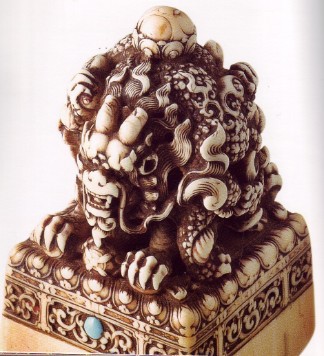
Source: http://www.tibet-encyclopaedia.de/siegel.html
Was it a reference to a seal? These were valuable indicators of power and authority at the time, and ’ja sa, official documents, could be identified by reference to their seals. The Red Annals, for example, refers to a ’ja sa of Gu shri’s crystal seal. [1] An ivory seal of a dragon’s head, set with a small turquoise stone, was given by the Ming emperor to the Fifth Pagmodru Desi, Grags pa rGyal mtshan, in 1406, and used by them for several centuries.
But this would not make sense of the orality implied in the term sgrog pa. This suggests that the zhal lce were proclaimed, like the roar of a turquoise dragon. Were they proclaimed at one of the great councils convened by the Pakmodru in 1373 (organised by Lama Dampa) and in 1415? This is often how decrees were publicized.
If so, why the turquoise dragon?
A donation inscription at a temple in Mulbekh reads:[1]
rgyal po’i mi chos dpa’ rtsal glang chen yu brug ’dra /
the worldly ways and bravery of the king resemble those of the elephant and the turquoise dragon.
The image is also found in the biography of the founder of the Bön religion, Shenrab Mibo (gTon pa gshen rab mi bo), the mDo dri med gzi brjid.
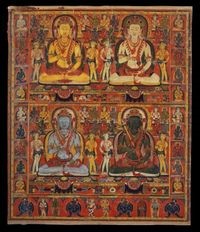
Source: http://www.hindupedia.com/en/Tonpa_Shenrab_Miwoche
The Prince talks of the need for a strong king, using a series of metaphors. They include:
ngar chen g.yu 'brug med na bung pas zer skad che/
Without the thunderous roar of the turquoise dragon the buzzing of the bees would be the loudest sound.
The Prince goes on to explain that the priest is, nevertheless, superior to the king:
bar snang mkha' la g.yu 'brug ngar che yang /
btsun snyan brjid ldan ka la bing ka yin/
Although the turquoise dragon may roar the loudest in the sky,
The kalapinga bird has the most sweetly melodious voice.
Here, the turquoise dragon is associated with distinctly royal, as opposed to religious, power and authority. This mirrors our legal text, in which the zhal lce concern the application of the king’s laws, as distinct from religious laws.
Also from this period is the rLang kyi po ti bse ru, the mythical genealogy of the Pakmodru rLang clan. Early passages glorify the clan and its lineage:
dpa' la btsun pa seng stag grus ma dang 'dra ba cig yin /
'jigs la ngar che ba nam mkha'i g.yu 'brug dang 'dra ba chig yin /
Brave and exalted, like lionesses and tigresses,
Terrifying and mighty, like the turquoise dragon in the sky,
Here, the power and might of the rLangs family are explicitly likened to a turquoise dragon.
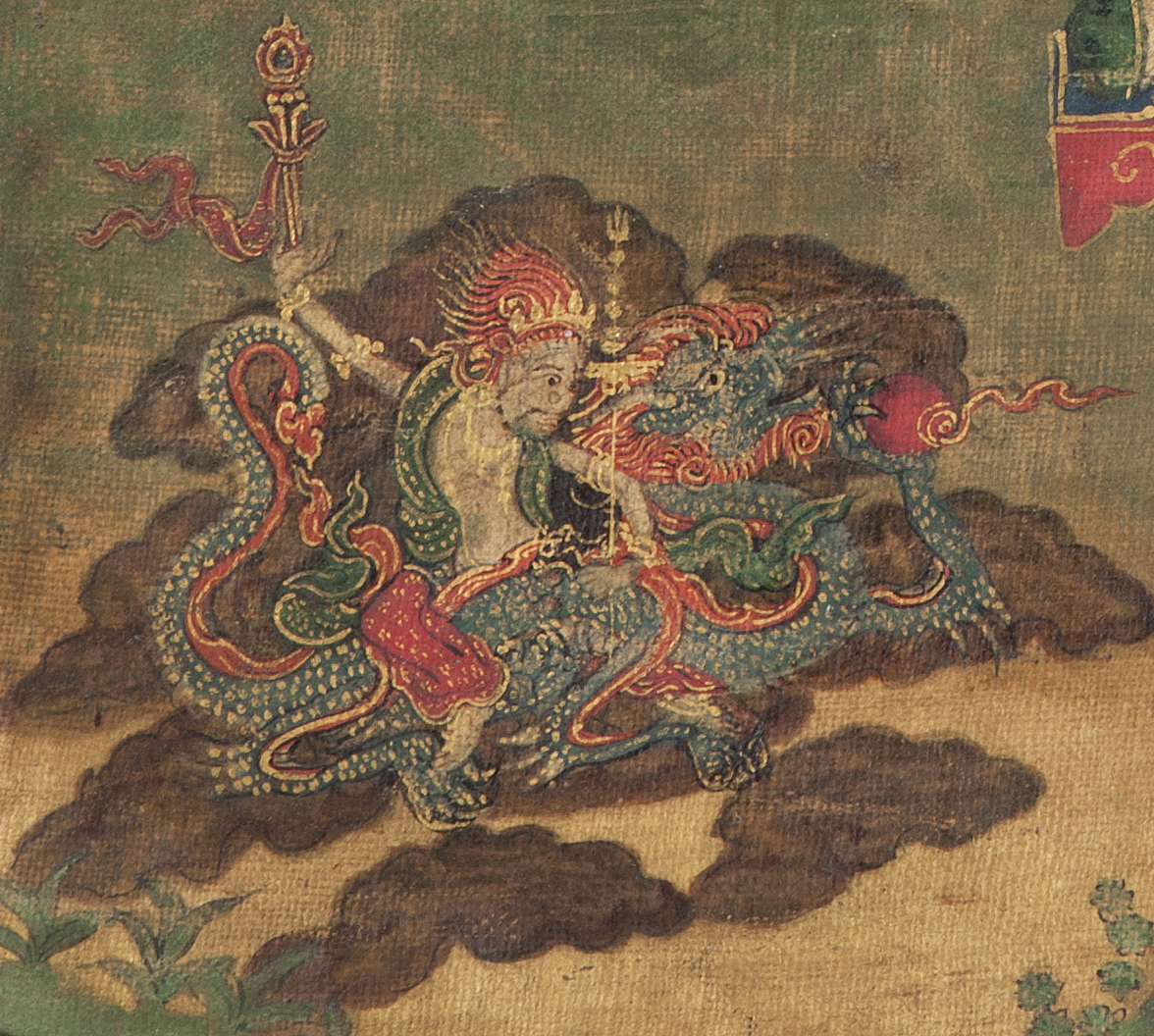
Rubin Museum of Art, C2001.3.5 (HAR 65011)
This, however, is not the end of the story. The image is also used with other meanings. Elsewhere in the Potiseru, the turquoise dragon is the source of water that tempers weapons. In the Gesar epic it is a protective deity. In the Tibetan History of Bon, one of the rMe’u scholars obtains supernatural powers and rides a turquoise dragon, using his rosary as a whip. Other deities ride turquoise dragons.
Mount Kailash is sometimes described as a mchod rten with four gates, of which the southern is the g.yu ’brug. In Chinese mythology, the green dragon of the spring resides in the east, and is associated with the source of a river. Tibetans, too, described rivers as turquoise dragons.
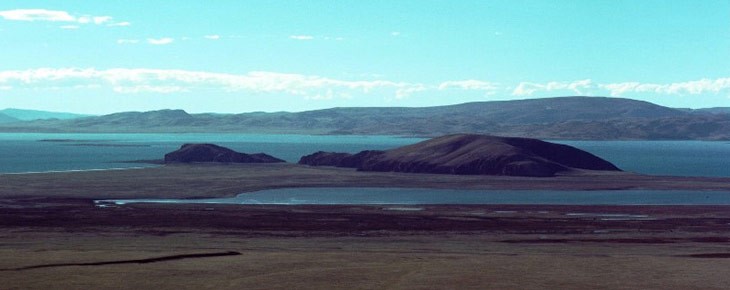
The bKa’ chems ka khol ma describes the sKyid chu as the g.yu chu sngon mo, the Padma bka’ thang describes the Yar lung gtsang po as a g.yu ’brug, and Lama Dampa refers to the sKyid chu, as the g.yu ’brug sngon mo.
The image of the turquoise dragon, it turns out, was rather common in this period. The author of our text could have been referring to China, in the east, still the seat of the gong ma, the ultimate legal authority. And the 1373 Pakmodru council was held at sNe’u gdong, on the banks of the sKyid chu. Or might the author simply have picked the image for its associations with power, geomancy, and the realm of the deities?
The turquoise dragon was undoubtedly an image of power and might, and specifically of royal status, however. In around the same period as the legal text, it was used in passages that distinguished royal from religious authority and it was specifically associated with the power and glory of the rLangs clan. It is, at least, likely that our author used the image deliberately, to symbolize the status of the rLangs family, just at the time they were trying to reinforce their shaky position as rulers of central Tibet.
[1] Pirie, Fernanda, forthcoming.'The making of Tibetan law: the Khrims gnyis lta ba’i me long'. In J. Bischoff, P. Maurer, and C. Ramble (eds), On a Day of a Month of a Fire Bird Year. Lumbini: International Research Institute.
[1] All textual citations are found in the extracts on this web-site.
[1] I am grateful to Nils Martin for this reference. He dates the inscription to 1332 or 1392.

